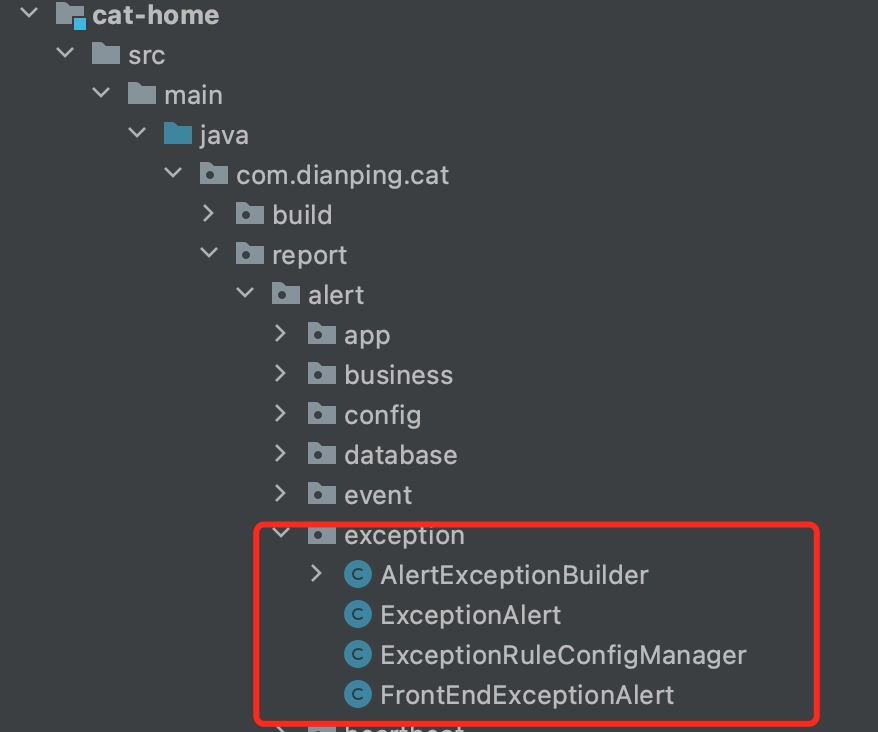10. CAT-报表视图
10.01 说明
数据从客户端采集,上报到服务端,进行各种不同类型报表的汇总统计与分析,最终以报表的展示形式展示在用户的面前,用户非常直观的发现自己在客户端埋点的信息,很快的发现和推断问题。
10.02 报表
在Cat平台中提供了很多的报表,其中,最关键的几个如下
- 报警统计
- 性能分析
- 调用链分析
- 报警配置
10.03 示例说明报表构建与展示
以报警统计说明报表的构建
10.03.01 维度要求
告警的类型很多,包含日常系统维护的很多方面。这里以最为关注的 `异常报警` 进行说明。
告警类型
public enum AlertType {
Business("Business"),
Network("Network"),
DataBase("Database"),
System("System"),
Exception("Exception"),
HeartBeat("Heartbeat"),
ThirdParty("ThirdParty"),
FrontEndException("FrontEnd"),
App("App"),
Web("Web"),
Transaction("Transaction"),
Event("Event"),
STORAGE_SQL("SQL"),
STORAGE_CACHE("Cache");
异常告警文件目录

异常统计维度
public class AlertException {
private String m_name;
private String m_type;
private double m_count;
public AlertException(String name, String type, double count) {
m_name = name;
m_type = type;
m_count = count;
}
public String getName() {
return m_name;
}
public String getType() {
return m_type;
}
@Override
public String toString() {
return "[ 异常名称: " + m_name + " 异常数量:" + m_count + " ]";
}
}
10.03.02 数据统计构建
CatHomeModule
@Named(type = Module.class, value = CatHomeModule.ID)
public class CatHomeModule extends AbstractModule {
public static final String ID = "cat-home";
if (serverConfigManager.isAlertMachine()) {
.....
FrontEndExceptionAlert frontEndExceptionAlert = ctx.lookup(FrontEndExceptionAlert.class);
.....
Threads.forGroup("cat").start(frontEndExceptionAlert);
FrontEndExceptionAlert
public class FrontEndExceptionAlert extends ExceptionAlert {
......
private void handleExceptions(List<Item> itemList) {
Map<String, List<AlertException>> alertExceptions = m_alertBuilder.buildAlertExceptions(itemList);
for (Entry<String, List<AlertException>> entry : alertExceptions.entrySet()) {
try {
String domain = entry.getKey();
List<AlertException> exceptions = entry.getValue();
for (AlertException exception : exceptions) {
String metricName = exception.getName();
AlertEntity entity = new AlertEntity();
entity.setDate(new Date()).setContent(exception.toString()).setLevel(exception.getType());
entity.setMetric(metricName).setType(getName()).setGroup(domain);
m_sendManager.addAlert(entity);
}
} catch (Exception e) {
Cat.logError(e);
}
}
}
@Override
public void run() {
boolean active = TimeHelper.sleepToNextMinute();
while (active) {
long current = System.currentTimeMillis();
Transaction t = Cat.newTransaction("AlertFrontEnd", TimeHelper.getMinuteStr());
try {
TopMetric topMetric = buildTopMetric(new Date(current - TimeHelper.ONE_MINUTE * 2));
Collection<List<Item>> itemLists = topMetric.getError().getResult().values();
List<Item> itemList = new ArrayList<Item>();
if (!itemLists.isEmpty()) {
itemList = itemLists.iterator().next();
}
List<Item> items = new ArrayList<Item>();
for (Item item : itemList) {
if (!Constants.FRONT_END.equals(item.getDomain())) {
items.add(item);
}
}
handleExceptions(items);
public class AlertExceptionBuilder {
@Inject
private ExceptionRuleConfigManager m_exceptionConfigManager;
@Inject
private AggregationConfigManager m_aggregationConfigManager;
public Map<String, List<AlertException>> buildAlertExceptions(List<Item> items) {
Map<String, List<AlertException>> alertExceptions = new LinkedHashMap<String, List<AlertException>>();
for (Item item : items) {
List<AlertException> domainAlertExceptions = buildDomainAlertExceptions(item);
if (!domainAlertExceptions.isEmpty()) {
alertExceptions.put(item.getDomain(), domainAlertExceptions);
}
}
return alertExceptions;
}
10.03.03 性能说明
在上面的代码中,数据存储在数据库或者服务器本地内存,磁盘中。
应对公司众多项目的埋点数据上报,必须导致服务端的资源消耗很大,上报数据,虽然做了域名性质的数据Hash映射,但是同样不能避免很大数据量,统计分析维度众多的情况下,必然带来的是大量的资源消耗,如,IO和CPU资源消耗。
从资源消耗上,看这个分析统计的功能更加适合使用实时数据组件进行统计和运算,这样从架构和资源角度看更加适合。但是使用实时数据分析,必然需要模块的拆分,同时导致链条变长,同时导致报表的数据查看,数据有一定的延迟。
10.04 小结
- 友好的视图展示,很大程度提升了系统的颜值
- 报表
构建&加载将是Cat最佳优化的点,它的优化将会很大程度的降低硬件系统资源




 浙公网安备 33010602011771号
浙公网安备 33010602011771号